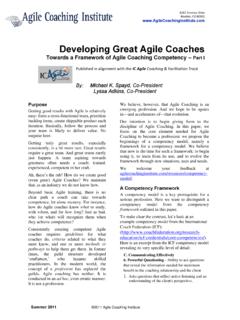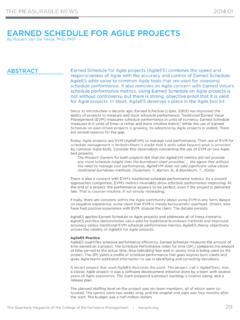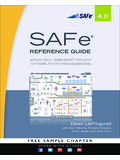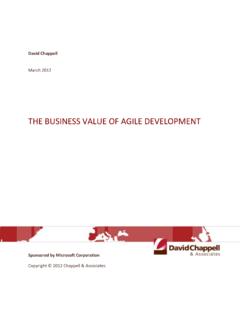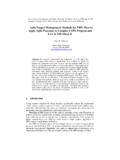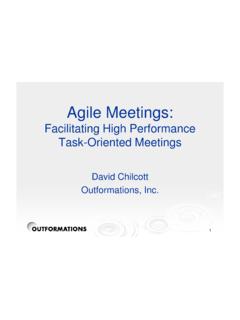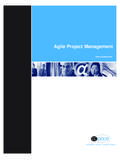Transcription of AGILE
1 AGILEHANDBOOK2 OVERVIEW3 OVERVIEWThis handbook is meant to be a quick-starter guide to AGILE Project Management. It is meant for the following people:Someone who is looking for a quick overview on what AGILE is and why it is who needs help getting their head around AGILE project who is scared to introduce AGILE on their next who needs help selling AGILE to their boss or guide is not meant to be the end-all-be-all to AGILE . Far from it. It is meant to give busy people an overview of the framework and its benefits in 15 minutes or less. The resources section lists recommended books and companies that can provide more robust training on how to implement AM I?And who am I to be writing about AGILE ? My name is Emerson Taymor and I m one of the co-founders of build better solutions to digital problems. We help startups, agencies and big companies with design and development. And we practice AGILE . Over the years, I ve seen waterfall and AGILE projects succeed and fail. I ve learned what makes them successful, and I ve fallen in love with the AGILE way.
2 I hope to share some of what I have learned within this short handbook. Feel free to reach out with any questions you might have. Thanks, Emerson 415-516-8341 @etaymor AGILE OVERVIEWA gile is a way to manage projects. It can be used for virtually anything, but it was founded in software development. This handbook focuses on AGILE for software development, but many of the principles can be expanded to other fields. AGILE breaks down larger projects into small, manageable chunks called iterations. At the end of each iteration (which generally takes place over a consistent time interval) something of value is produced. The product produced during each iteration should be able to be put into the world to gain feedback from users or stakeholders. Unlike Waterfall project management, which is strictly sequenced: you don t start design until research is done and you don t start development until the designs are signed off on; AGILE has designers, developers and business people working together GOALSAs made popular by the AGILE Manifesto , AGILE values:Individuals and interactions over processes and toolsWorking software over comprehensive documentationCustomer collaboration over contract negotiationAgile realizes that software (and marketing) projects are inherently unpredictable.
3 Over the course of any project there are likely to be changes. Be it market changes or feature changes as the product comes to life. AGILE embraces this unpredictability. By breaking down projects into small chunks, it makes it easy to prioritize and add or drop features mid project. Something that is impossible in traditional waterfall projects. Responding to change over following a plan7 THE 12 highest priority is to satisfy the customer through early and continuous delivery of valuable software. working software frequently, from a couple of week to a couple of months, with a preference to the shorter timescale. changing requirements, even late in development. AGILE s processes harness change for the customer s competitive advantage. 4. Business people and developers must work together daily throughout the projects around motivated individuals. Give them the environment and support they need, and trust them to get the job done. most efficient and effective method of conveying information to and within a development team is face-to-face conversation.
4 Software is the primary measure of progress. processes promote sustainable development. The sponsors, developers, and users should be able to maintain a constant pace indefinitely. attention to technical excellence and good design enhances the art of maximizing the amount of work not done is essential. best architectures, requirements, and designs emerge from self-organizing teams. regular intervals, the team reflects on how to become more effective, then tunes and adjusts its behavior STANDS OUT11 WHY AGILE ROCKSSPEED TO MARKETFLEXIBILITYRISK MANAGEMENTA gile lets you get your concept to your users as quickly as possible. During every sprint an AGILE project delivers something of value. At any point, you may determine you want to launch what has been delivered and start building a user base or testing your hypothesis. AGILE is based on accommodating change. Software projects consistently change. As a product comes to life or the market expands, you should be able to react and update the product accordingly.
5 AGILE also realizes that great ideas are bound to come mid-project and being locked into a scope doesn t let you take advantage of these realizations. Incremental releases means that the product can be used early in the process by stakeholders and users. This lets you identify issues and feature deficits early in the process. Being adaptable to change means it isn t a problem to change the scope midway through the project, something that would be impossible in a waterfall style CONTROLU nlike a fixed budget project, AGILE is flexible with regard to scope. More often than not, our clients realize features they originally requested are no longer necessary. This allows them to launch sooner and pay less. AGILE isn t about paying a lot with uncertainty, it s about paying for only what you need. Need to stick within a budget? No problem! We can rearrange the product backlog so that critical new features are implemented at the expense of less important features, not your integrates testing throughout the process.
6 Consistently delivering tested software means higher overall quality and less time spent on QAing the full application. RIGHT PRODUCTI ncremental releases let you test your product early and often. Even if you don t release it to the public, it s much easier to locate flaws and things that can be improved when you have an actual product to play with vs a series of lets you see, feel and use a project consistently throughout the project. You don t see things in compartmentalized silos; you see how things work MISCONCEPTIONSIT S DIFFERENT I ve never used AGILE before and I m scared it will be too hard to get my whole team on board with it. We ve heard it before. Too many times. And we realize AGILE may be new to you and your company. But while it might take a slight rewiring of how stakeholders think about projects from the onset-- and how designers and developers are used to working at your firm-- it quickly becomes apparent that projects consistently run smoother on AGILE . And better results are produced.
7 Plus, you likely can admit that waterfall isn t the perfect process. While it might feel like it is more under control because everything is mapped out from the beginning, projects undoubtedly take longer than they need to and cost more than they should. Waterfall also doesn t allow the flexibility to change things mid-project as new insights come to BUDGET I have a fixed budget. That doesn t work with AGILE ! Au contraire! Nothing about AGILE says it can t meet a strict budget. AGILE gives you dedicated resources. Generally, there is a fixed cost to a sprint that includes X team members. An AGILE team can estimate approximately how long it will take to complete the goals that you have outlined and that will give you a budget. As the project evolves and you choose to add a new feature, AGILE lets you drop a similarly sized feature so that you can stick to the initial S UNPREDICTABLEA gile can be unpredictable. But all projects are unpredictable. It is impossible to know exactly what your end users want.
8 AGILE embraces this unpredictability and leverages it to produce better MAKE ALL THE FEATURESA nother common misconception of AGILE is that the developers get to choose what is important and what is implemented when. That could not be further from the truth. Before each sprint begins there is a comprehensive sprint planning meeting where all the key stakeholders determine which features will be implemented in that sprint. This meeting includes developers, designers, business people and anyone else involved in the product. Not just developers determining what to build DOESN T CONSIDER THE LONG-TERMSome people believe that because AGILE focuses on short-iterative releases it doesn t take into account the long-term needs and goals. AGILE actually benefits the long term. At a minimum, it is just a different means to get to the end. By having something that you can actually test earlier in the process, it lets you make better decisions for the REQUIRES MORE TEAMWORKA gile requires collaboration between designers and developers.
9 Fortunately, most designers and developers love to collaborate. While there can be a bit more upfront work to get everyone on the same page, the end result is a better product, faster and for less AGILE WORKS17 THE AGILE LIFECYCLET here are many different flavors of AGILE . Ultimately, it is up to your team to come up with the best process for you. Generally they all follow a short life cycle, which repeats during each iteration. This guide focuses on Scrum, but many of the features are universal. Scrum projects are broken down into short iterations (generally 1 - 3 weeks) called sprints. The lifecycle of each sprint includes:1. PLANNING2. EXECUTION3. REVIEW4. RINSE & REPEAT18 KICKOFF/SPRINT PLANNINGEach scrum project begins with a kick-off meeting. The first meeting is generally the most extensive as the initial project backlog needs to be created and the project team introduced. Additionally, before each of the future sprints there is a sprint planning meeting. First, the kick-off meeting.
10 The kick-off meeting s goals are:1. An overview of the project and the Who will be working on the Determining the point person for client Creating the project Determining which features to work Getting on the same BACKLOGB ehind every project is a project backlog. The project backlog is a list of all the product features generally defined by user stories . User stories define everything potential users want to do on the site. They are defined for each of the user groups on the site and are structured like:AS A [type of user], I WANT TO [do this thing], SO THAT I CAN [accomplish this goal]. 20 There are many tools to keep track of your project backlog, both analog and digital options. The important thing is that the backlog is always accessible and easy to track. In its most basic form it might be post-it notes on a wall. In fact, one of the best ways to create the initial project backlog is to write all of the user stories on post it notes during the kick-off meeting. Post-it notes are easy to rearrange so make a perfect analog solution to creating a backlog.
